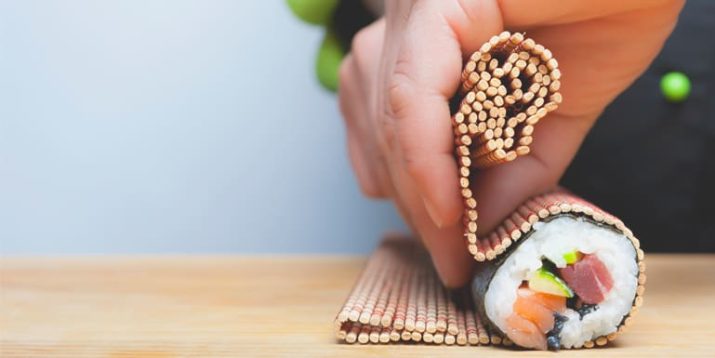How to Make Sushi

Everyone has those nights when they’re not sure what to eat for dinner. Whether you’re eating out or aggressively scrolling through an online batch of menus, you want to enjoy your meal — treat yourself, even. And while it’s tempting to order the thick, juicy cheeseburger and fries, what’s a better option that’s good for the body and soul than good ‘ol sushi?
This Japanese dish is shoveled into the mouths of millions daily, but it’s not just for eating at restaurants or ordering takeout. The simple mix of rice, vegetables, and fish can be a tricky one, as one too many soy sauce dips, or that extra dollop of spicy mayo may put you over the edge. Lucky for you, we’re here to help you avoid all of that.
For a healthy sushi recipe, 21 Day Fix celebrity trainer Autumn Calabrese and her brother, Chef Bobby Calabrese created this quinoa-based sushi roll for their Beachbody On Demand cooking show, Fixate. Check it out today!
We’re not saying you shouldn’t eat more than one roll at a time, but here’s how to make your very own sushi, in its healthiest form possible. Below calls for enough ingredients for one roll, so be prepared to double if you’re cooking for two! (Or just extra hungry…)
The Healthiest Way to Make Sushi
1. Prepare the rice.
While shiny, white rice (also known as sushi rice) is typically the grain of choice, we recommend going brown this time around. This easy switch will up your fiber intake, filling you up faster with a healthier option. Rinse about a cup of rice in a fine-mesh strainer until your water runs clear. Then, add to a medium saucepan with two cups of water and bring to a boil. Once it boils, reduce heat to low, cover and cook until water is completely absorbed, about 15 minutes.
To give your rice a similar taste to typical sushi rice, combine it with a pinch of salt and rice wine vinegar.
2. Build the outside of the roll.
Wrap a sushi mat (see “tools” below) in plastic wrap and place a sheet of nori (seaweed) on top. You can also toast your nori prior to beginning this step to add a bit more flavor, but it is not a requirement for the dish’s completion. Grab a sparse handful of cooked, seasoned rice, and, starting in the center, spread it out across the nori. Begin with less rice, as it’s easy to add on more if necessary.
3. Fill the sushi roll.
From eel to egg, and avocado to ahi tuna, there are an array of options to fill your sushi rolls. If you’re going the vegetarian route, aim to pick bright veggies such as cucumber, carrots, peppers, and avocado. Add some heft with a slice of avocado; it’s a better option than a chunk of cream cheese (due to its healthy fat content). Lots of fresh and pickled vegetables paired with creative options such as chopped peanuts, and toasted sesame seeds, can provide filling rolls that are as attractive to look at as they are tasty to eat.
If you’re in the mood for protein-filled fish, make sure you purchase it from a location where it has been properly stored and frozen to remove any unwanted parasites. Make sure to use fish within two days of purchase. Don’t feel embarrassed to ask when it was delivered to the shop, and if you smell anything “fishy,” opt for something else! When it comes to selection, shoot for something high in omega-3s, such as salmon or tuna, but lay off the heavy sauces (as tempting as they may be). Your condiment-less concoction can still be flavorful with ginger or wasabi on the side instead.
When it comes to proper knife usage, aim to slice fish using a 8- to 10-inch blade that’s very sharp. Go across the grain with one large stroke, completing a thin, appealing piece, suitable for rolling.
4. Roll the sushi.
Once you’ve spread out the rice, top it with sliced fish, vegetables, or the fillings you desire. Place the toppings in a one-inch row at the edge of the side of the sushi mat that’s closest to you. Now that the filling has been added, fold the mat on top of itself, making a tight rectangular shape and continuously moving until you’ve reached the end of the nori.
Gif by yaydrienne
Wipe the blade of a knife with a damp towel and cut through the roll into six to eight pieces. And just like that, you’ve made healthy sushi! While there’s a possibility it may not look like exactly like a restaurant roll, it’s a homemade, nutritious meal.
What You Need to Make Healthy Sushi at Home
Essential Homemade Sushi Kitchen Tools
- Sharp knife (No, you don’t have to pony up for a fancy sushi knife, but a sharp blade is key for precise cuts.)
- Bamboo rolling mat
Fancy Homemade Sushi Kitchen Tools
If you want to step up your homemade sushi-making skills, these tools can help you feel like a pro.
- Sushi Oke/Hangiri: This shallow, flat-bottomed bowl made from wood from Japanese cypress trees helps absorb excess moisture from cooked, seasoned sushi rice; spreading the hot, cooked rice out in the bowl helps it cool faster.
- Bamboo rice paddle: Used to scoop and handle rice, these metal-free wooden spoon won’t react with the rice vinegar used to season the sushi rice and create any potential “off” flavors.
- Rice cooker
Homemade Sushi Grocery List
Essential Ingredients:
- Roasted seaweed sheets (Nori)
- Brown or sushi rice
- Rice vinegar
- Reduced-sodium soy sauce
- Fish, if desired
- Vegetables, such as avocado, cucumber, carrots, bell peppers, pickled radish
Optional Ingredients:
- Pickled ginger
- Wasabi
- Sesame seeds

